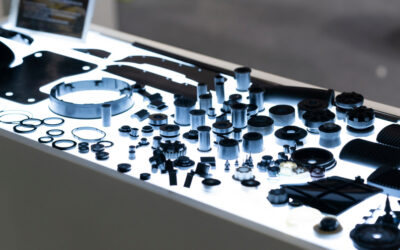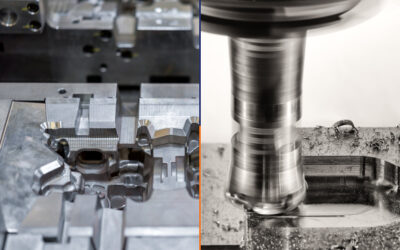Metal heating processes have been used since the ancient times. Back in the days, blacksmiths heat-treated metal to shape it into horseshoes, or wagon parts. And as the years go by, heating metal remains the most effective way to form it into the desired shape.
However, nowadays, heat treatment of metals has become a much more sophisticated and precise process. Using modern machining, engineers can now shape metals for various purposes much more efficiently.
But there’s much more to metal heat treating than meets the eye. These processes not only help engineers shape metals. They also change several metal properties, including hardness, strength, formability, and elasticity.
In this guide, we’ll discuss in more detail what heat treatment for metals is, as well as heat treatment types, processes, and purposes.
What Is Heat Treatment of Metals?
In simple terms, metal heat treatment includes heating and cooling of the material. The metal or alloy is first heated to a specific temperature to make it more formable, and then it is cooled down to harden it.
The goal of a heat treating process is to bring out the desired mechanical, chemical, and physical properties of metal by changing its microstructure. Such alterations can make the metal stronger, more resistant to abrasion, more ductile, or more resistant to temperature.
Of course, metal heating occurs in practically every metal process, be it welding or laser cutting, but heat treatment processes are more controlled.
Summing up, heat treatment of metals plays a vital role in metal manufacturing processes. It allows engineers to select the material’s properties, as well as make it more resistant to wear and tear.
How Does a Metal Heat Treatment Process Work?
Although there are several types of metal heat treating processes (we will discuss them further in the article), they all follow similar stages. These stages typically are:
- The heating stage, where the metal is heated to a specific temperature.
- The soaking stage, where the material is held at a specific temperature for a given period of time.
- The cooling stage, where the metal is cooled to room temperature.
We discuss them in more detail below.
The Heating Stage
The first step is to heat the metal to the required temperature. During this stage, it’s essential to ensure that the material is heated uniformly. That is why heating is performed slowly.
If you were to heat the metal unevenly, some sections might expand faster than others, resulting in cracks and warps.
The heating rate is chosen based on the following variables:
- The metal’s heat conductivity – the higher the conductivity, the faster the material will heat;
- The material’s condition – if the metal has already been hardened or stressed before, it should be heated slower than the material that hasn’t;
- The size and cross-section of the material – larger parts with uneven cross-sections need to be heated slower, as there’s a risk of excessive warping and cracking.
The Soaking Stage
Before cooling, the metal goes through the soaking process. Its purpose is to keep the material at a specific temperature until it changes its structure to the one desired.
The time during which the metal is ‘soaking’ is called the ‘soaking period.’ Engineers determine it based on the chemical analysis and metal’s mass.
The Cooling Stage
Finally, there’s the cooling stage during which the metal is cooled back to room temperature. The cooling method will depend on the metal. In most cases, it will need a cooling medium – in a liquid, solid, gas form, or a combination of them.
The metal and medium also affect the cooling rate and method. For example, you can use quenching. It involves cooling the metal rapidly using air, oil, water, brine, or another medium. For example, water quenching is often used when working with copper.
However, it’s important to note that quenching can crack or warp some metals. As a rule of thumb, water quenching can be used to cool carbon steel, whereas slower methods are better to harden alloy steel.
What Are the Metal Heat Treatment Types In Machining?
As mentioned earlier, there are several types of heat treatment. And while they all follow similar processes of heating, soaking, and cooling, they all come with different purposes in machining.
The four types of metal heat treatment are:
- hardening,
- tempering,
- annealing,
- and normalizing.
Hardening
Hardening is the process of heating the metal to a specific temperature and quenching it as quickly as possible.
The metal is first heated to a temperature where the elements present in the metal go into the solution of fine particles, strengthening the material. Rapid quenching then helps to trap these particles in the solution.
The purpose of this process is to strengthen the metal. Hardening also makes the metal more brittle while decreasing its ductility. That is why it’s recommended to temper the metal after hardening.
Tempering
Like hardening, tempering’s purpose is to increase the steel’s resilience. In this case, however, the metal is heated to the temperature below the critical point, which maintains hardness while reducing brittleness.
It helps reduce hardness caused by hardening, enabling technicians to develop new physical properties for the metal. For this reason, tempering often follows hardening during heat treatment processes.
Annealing
During the process of annealing, the metal is heated to a specific temperature, holding it in that temperature to transform and then cooling it.
Annealing is suitable for metals like aluminum, steel, copper, silver, and brass, and its purpose is to decrease the metal’s hardness while increasing its ductility. So, in other words, annealing is the opposite of hardening.
As for the cooling process, it can be quicker when annealing silver, copper, or brass. However, when working with steel, cooling should occur slowly and gradually to be effective.
Normalizing
Normalizing is essentially another form of annealing. The difference is that the metal is heated to a higher temperature.
Once heated, the metal is held at that critical temperature until transformation, and then the air is cooled. The process leads to smaller austenitic grains, with air cooling helping to produce ferritic and more refined grains.
The purpose of normalizing is to remove internal stress from metals, which can lead to metal failure when not taken care of. Once the metal is normalized, technicians use hardening to strengthen the material and ensure the manufacturing process is successful.
Why Are Metals Heat Treated?
Heat treating metals is an imperative part of metal manufacturing. Without the process, producing parts for devices and equipment wouldn’t be possible, as then they wouldn’t function properly.
Heat treatment ensures metals like steel and aluminum are strong enough to withstand specific applications. For example, heat-treated metals are used in airplanes, cars, and other products that rely on metals with increased strength and resistance.
Heat treating processes also improve metals’ durability. That is why heat-treated metals have become the core of cost-effective machines, as they are more efficient and less prone to damage.
However, heat treating metal doesn’t only provide application benefits. It also offers numerous advantages to manufacturers. For instance, a heat treatment process relieves internal stresses within the material, making it far easier to weld or machine.
If we were to summarize all the advantages of heat treatment processes, the list would include the following:
- Increased material’s strength while making it more ductile and flexible;
- Decreased internal stresses, making the material easier to weld or machine;
- Improved brittleness;
- Introduced wear-resistant properties to the material;
- Improved the metals’ electrical and magnetic properties.
Key Takeaways
Summing up, heat treatment for metals is a process of heating, soaking, and cooling the material. During the heat treatment process, the metal changes its microstructure, resulting in improved strength, durability, brittleness, and flexibility.
There are several types of metal heat processes, with the most common being hardening, tempering, annealing, and normalizing. And while all follow the same processes, their purposes are different.
Heat treating is vital to improve the metal’s mechanical properties, resulting in the material’s improved compatibility with other materials and parts.
That is why heat-treated metals are used in applications and products requiring increased strength and resistance, such as airplanes, cars, or machines.
However, while heat treating can improve one’s products, it has to be performed by qualified technicians. This is where Gensun Precision Machining can help. Contact us today to learn more about our services and see how we can help you with your projects.



